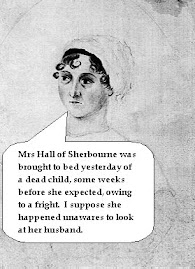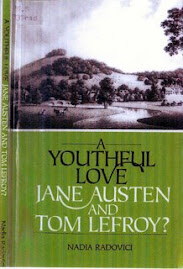"Of personal attractions she possessed a considerable share. Her stature was that of true elegance. It could not have been increased without exceeding the middle height. Her carriage and deportment were quiet, yet graceful. Her features were separately good. Their assemblage produced an unrivalled expression of that cheerfulness, sensibility, and benevolence, which were her real characteristics. Her complexion was of the finest texture. It might with truth be said, that her eloquent blood spoke through her modest cheek. Her voice was extremely sweet. She delivered herself with fluency and precision. Indeed she was formed for elegant and rational society, excelling in conversation as much as in composition."
It has been noted that part of Henry's description - "her eloquent blood spoke through her modest cheek" - owes a debt to the poet John Donne, and consequently to Henry Fielding, who employed the same passage in Tom Jones (see my earlier post on this blog: Jane Austen & "Sophia Sentiment").
 However, in the same Biographical Notice, Henry (at left) also avows that his sister had her reservations about Fielding. This latter assertion needs to be taken with a large grain of salt, considering the references in Jane's letters and the themes and character names used by her that also appear in Tom Jones. (A few of these have been pointed out by Jon Spence in Becoming Jane Austen, although a diligent reader will discover plenty more that he did not specifically note.)
However, in the same Biographical Notice, Henry (at left) also avows that his sister had her reservations about Fielding. This latter assertion needs to be taken with a large grain of salt, considering the references in Jane's letters and the themes and character names used by her that also appear in Tom Jones. (A few of these have been pointed out by Jon Spence in Becoming Jane Austen, although a diligent reader will discover plenty more that he did not specifically note.)Re-reading the famous Tom Lefroy white coat reference will reveal that the similarity to Jones is one envisaged by Jane Austen, not one that Lefroy himself professed or was necessarily aware of. "He is a very great admirer of Tom Jones, and therefore wears the same coloured clothes, I imagine, which he did when he was wounded." (Jane to Cassandra, 9 January 1796, emphasis in bold added).
Henry Austen's tribute to his deceased sister can therefore be considered the first of many attempts by her relatives to whitewash her image, whereby the sharp and witty Jane Austen becomes transformed into that sanctimonious creature, Saint Jane. Personally, this blogger much prefers the Jane whose halo is just ever so slightly askew!
















No comments:
Post a Comment